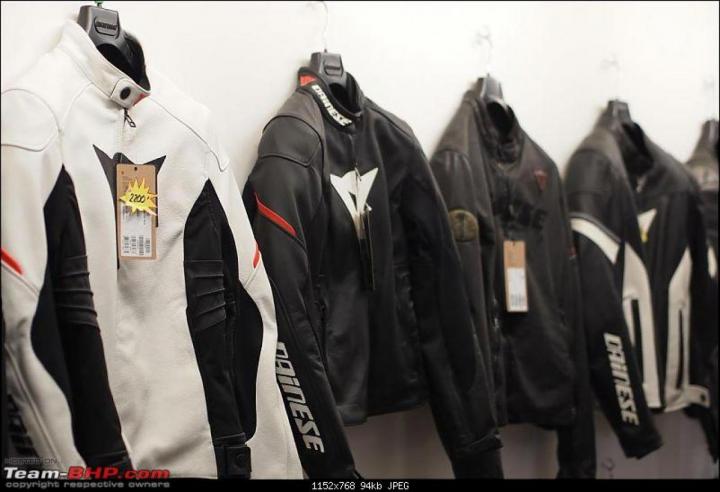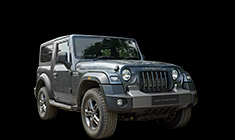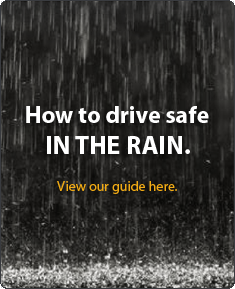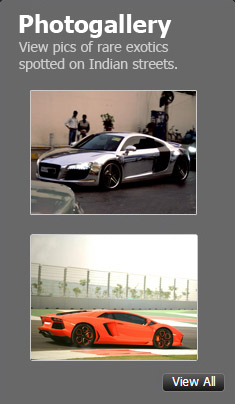News
Motorcycle riding gear: A guide to its terminologies, standards & more
These are some of the standards relevant to motorcycle jackets and pants.
BHPian Karthik.guru recently shared this with other enthusiasts.
Greetings folks!
I was recently in the market for some riding gear and was only aware of basic terms such as CE Level 1 and Level 2. I had a total budget of 10k and wanted the best protection I could find in that price range. Narrowed down to a Tarmac Drifter II jacket and the Royal Enfield Carapace Riding Denim as both of them offered CE Level 2 protection. Being my first set of riding jackets and bottoms, I immediately dismantled them both to have a closer look. Upon removing the armour from their respective pockets, it seemed I had found hieroglyphics on the armour! Being a researcher by trade, I couldn't help but dig deeper into CE labels and rating terminologies and wanted to share my findings here. I have tried my best to corroborate each piece of information from at least 2 sources.
TLDR: it's complicated but you get what you pay for, and always take a closer look.
CE (Conformité Européene) or European Conformity is a globally accepted standard which covers personal protective equipment (PPE). CE Tested, CE Rated and CE Approved are three different types of certifications and should not be interchanged.
- CE Tested - one or multiple parts of the garment tested by the manufacturer as per CE standards
- CE Rated - one or multiple parts of the garment tested by certified labs
- CE Approved - multiple parts of the garment tested by certified labs
Personally, I found it difficult to understand the difference between CE Rated and CE Approved, judging by the definition there must be some overlap between the two. More importantly, from what I understand, CE Certified can mean any of these. This presents a clear opportunity for a little marketing trickery. But how much can this affect the safety aspects of the gear? I do not know. I did not look into enforcement by CE of their standards, particularly for CE Tested gear. However, I would imagine that manufacturers follow these standards diligently since any infraction must have severe legal repercussions, not to mention the potential loss of life.
Still, pretty easy to understand so far, right? Keep going.
Within these ratings are various standards:
- EN13634 relevant for boots
- EN12594 relevant for gloves
- EN13595 and EN17092 relevant for jackets and pants
- And lastly, EN1621 covers impact protectors which can cut across the above.
Please note that this nomenclature is followed by a ": year" which refers to the year in which the standard was updated (they are required to be updated every few years). Naturally, the most recent one is the best. For example, EN1621-1:2012 means that the standard EN1621-1 was updated as of 2012. I have ignored the year for most of the article in order to keep the jargon to a minimum.
For the sake of brevity, we’ll only go into the standards relevant to motorcycle jackets and pants.
Now, before we even begin, there is a need to distinguish between professional and leisure use. Professional use-case refers to any profession that requires the use of motorcycles (i.e. someone who delivers letters, parcels or other small freight; the transport of passengers by motorcycle; emergency medical treatment; or vehicle breakdown support). Leisure is everything else, which includes the sort of riding most people reading this would partake in (including commuting!). Now, let's start deconstructing.
EN13595
Implemented in 1994, this was developed and regulated for garments meant for professional use and is slide tested. However, since it was intended only for professional use, the industry ignored it for many years and supplied riding gear which did not necessarily conform to these standards arguing that most motorcycle riders fall under the “leisure” category. After years of deliberation, the next standard was developed.
EN17092
Implemented in 2017, this standard was developed specifically for the “leisure” use-case of motorcycles and already sees more use than EN13595. These garments are tested for abrasion, tear strength, seam strength, dimensional stability (how it holds up after sustained washes) and innocuousness (safety/hazard of chemicals used in construction). These garments are then classed from AAA to C, AAA being the safest.

The CE labels for these are also pretty straightforward with only 3 sections;
A pictogram at the top that depicts that the garment is meant for motorcycles, the class rating in the middle and the certification standard at the bottom. Like the others, EN17092 also has several sub-categories, 5 in total, i.e. EN17092-2 to 6. However, a consumer-friendly move by CE was to keep each class unique to each sub-category, so as a consumer, you need only look at the class of the garment and maybe the year within the standard. That is:
- EN17092-2 = AAA -> protection against impacts AND abrasion (highest level of protection)
- EN17092-3 = AA -> protection against impacts AND abrasion (ideal for touring)
- EN17092-4 = A -> protection against impacts AND abrasion (suitable for urban riding WITH impact protectors)
- EN17092-5 = B -> protection against abrasion ONLY (suitable for urban riding WITHOUT impact protectors)
- EN17092-6 = C Over(CO)/ Under(CU) -> impact protection by one or more impact protectors ONLY
Unsurprisingly, in my search for affordable riding gear (5-6k per garment), I have found no mention of this rating anywhere. However, while researching for this article, I came across a few jackets in that price range from some manufacturers who claim to be AA Certified. But I suspect some marketing trickery as I’ve mentioned earlier. Naturally, I will not be naming said manufacturers as I am not 100% certain of my suspicions. I tried to trace back their licensing documents but to no avail. I suppose it will take a much sharper mind than mine to crack that nut. Moving on.
EN1621
Sounds familiar? Rightly so. It refers to the impact protectors used in most jackets from generic brands all the way to top-of-the-shelf gear. So when you read “Level 2 Jacket” or “Level 2 Pants”, it means that the impact protectors used in the jacket are Level 2 and it is no comment on the garment’s performance against abrasion or tear.
This standard has 3 sub-categories:
- EN1621-1 Refers to limb protectors.
- EN1621-2 Refers to spine protectors.
- EN1621-3 Refers to chest protectors.
Impact protectors are rated based on how much force from an impact they transmit to the user, based on which they are rated at either Level 1 or Level 2. But what does that mean? Instead of going into how much kN of force they transmit (which varies between each sub-category of protectors), the key takeaway is that Level 2 protectors are roughly twice as good as Level 1. Please note that there are also EN1621-4 & 5 which refer to air vests but since they are rare in our market, I have not covered them.
Managed to follow so far? Awesome. Now come the hieroglyphics!
Each impact protector has a label which looks something like this.
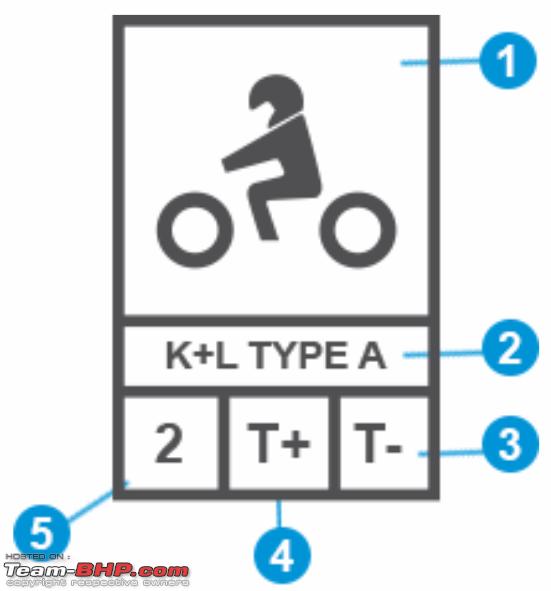
Above this label is usually the name of the manufacturer and below it is the certification standard it conforms to. The nomenclature for 1, 3, 4 and 5 are common between the three sub-categories of impact protectors.
- 1- A pictogram which depicts that the protector is intended for motorcycle use. Other possibilities are snowmobiles, gardening, medical use etc
- 3- Denotes that the impact protector has been validated for temperatures of -10°C. If blank, then it has not been validated for -10°C.
- 4- Denotes that the impact protector has been validated for temperatures of +40°C. If blank, then it has not been validated for +40°C
- 5- States whether the impact protector is level 1 or level 2.
- 2- This gets a bit complicated as it is different for limb, spine and chest protectors. We will cover them one by one
For limb and chest protectors, it is in the following format with two variables: (x) TYPE (y)
Variable x
- S - Shoulder
- E - elbow
- H - hip
- K - knee
- L - front of the leg below the knee (Upper and Middle Tibia) (used for leg guards)
- KP - knuckles (used only for gloves)
- C - chest (i.e. the protector is a single piece)
- DC - divided chest (i.e. the protector is in 2 pieces)
Variable y
This one is pretty straightforward forward with only 2 possibilities:
- TYPE A - the protector has reduced coverage for specialised applications
- TYPE B - the protector has normal coverage
Some protectors are designed to be interchangeable or perform multiple functions, in which case they will read with a ‘+’ in the middle. For example, S+E+K TYPE A = the protector can be used for EITHER shoulders, elbows or knees and has reduced coverage. K+L TYPE B = the protector is for the knee AND front of the leg and has full coverage (used for leg guards)
For spine protectors
There are only 3 possibilities for section 2 of the pictogram:
- B or FB - indicates that the protector covers the entire back (central back and scapulae)
- CB - indicates that the protector covers the central back only
- L or LB - indicates that the protector covers the lower back only
Spine protectors also should ideally be chosen based on the proportions/size of their users. As such the label also has a large image depicting the ideal waist-to-shoulder dimensions (which is essentially the length of their back). For Example, this is a Central Back protector ideal for someone with a waist-to-shoulder dimension of 49-52 cm.
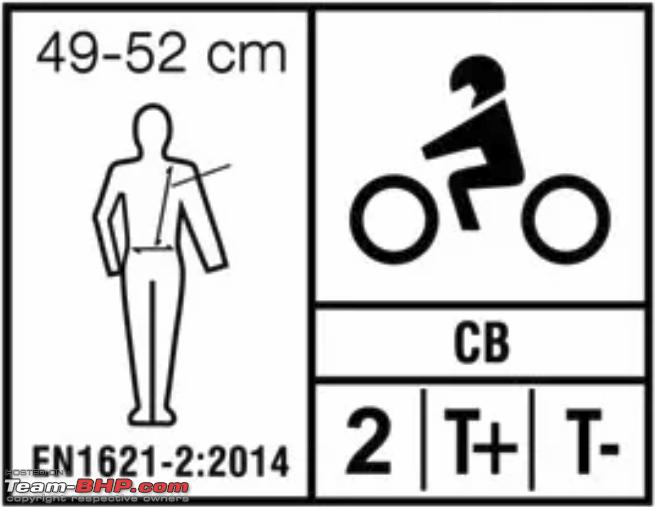
Conclusion
The nomenclature behind riding gear can get pretty confusing unless you spend days researching every term you find. IMHO this is mainly due to the fact that motorcycle gear is covered under PPE which is a very long list of garments that need to be certified for a multitude of specialised applications. With the advent of EN17092 in 2017, things have already gotten much easier for consumers based on what I have come across. I expect the same to trickle down to lower price ranges soon as well.
Personally, I found that the protectors on my newly purchased jacket are not tested for temperatures over 40°C but they are tested for -10°C. This is strange considering that it is a mesh jacket meant to be worn during Indian summers. I also found that the back protector isn’t temperature tested at all! But I suppose you get what you pay for. Would I have still bought it had I known this before buying? Maybe not, might have looked at slightly more expensive gear just for that T+ label.
Hope I’ve helped you understand this realm a bit better and thank you for reading. <3
Cheers!
References:
- FortNine Youtube Channel - Awful & Awesome Motorcycle Gear - How to Spot the Difference
- FortNine Youtube Channel - Best Beginner Motorcycle Gear – What Do You Really Need?
- BikesRepublic
- MotorcycleGear
- RevitSport
- RiderMagazine
- Bennetts.co.uk
Check out BHPian comments for more insights and information.
- Tags:
- Indian
- Member Content
- riding gear



